How Much Does Ceiling Fan Installation Cost in Australia?
When installing a ceiling fan in Perth, it is required to have a licensed residential electrician to handle the proper wiring and comply with safety standards, such as understanding electrical wiring colours in Australia. Rates of residential electricians vary depending on the job’s complexity. As part of the safety procedures, it is highly discouraged to allow an unlicensed person to do the work. You can consult qualified residential electricians in Perth, like the Dynamic Group to ensure your electrician ceiling fan installation cost delivers value, professionalism, and peace of mind.
- Basic ceiling fan replacement (with existing wiring): From AUD 115
- New installation (with new wiring): From AUD 390
- Ceiling fan with light or high ceiling installations: Additional cost from AUD 75
Note: The overall ceiling fan installation cost may increase based on wiring conditions, presence or lack of changeover switches, fan features, and other installation factors. Make sure that you will allot an extra budget for unexpected expenses when planning the cost of installing ceiling fans, such as addressing issues with a short circuit and how to fix it because it can affect the final fan installation cost. .
Ceiling Fan Installation Cost Summary
| Service Type | Cost Range (AUD) |
|---|---|
| Ceiling fan replacement with existing wiring | 115-310 |
| New fan installation with new wiring | 390-930 |
| Ceiling fan with light installation | 75-155 |
| High/vaulted ceiling surcharge | 75-230 |
Pro Tip: Strategise your installation schedule. Have all the fans and components ready to negotiate a bundled rate, rather than paying per visit.
Contact Dynamic Group for competitive pricing from qualified residential electricians in Perth.
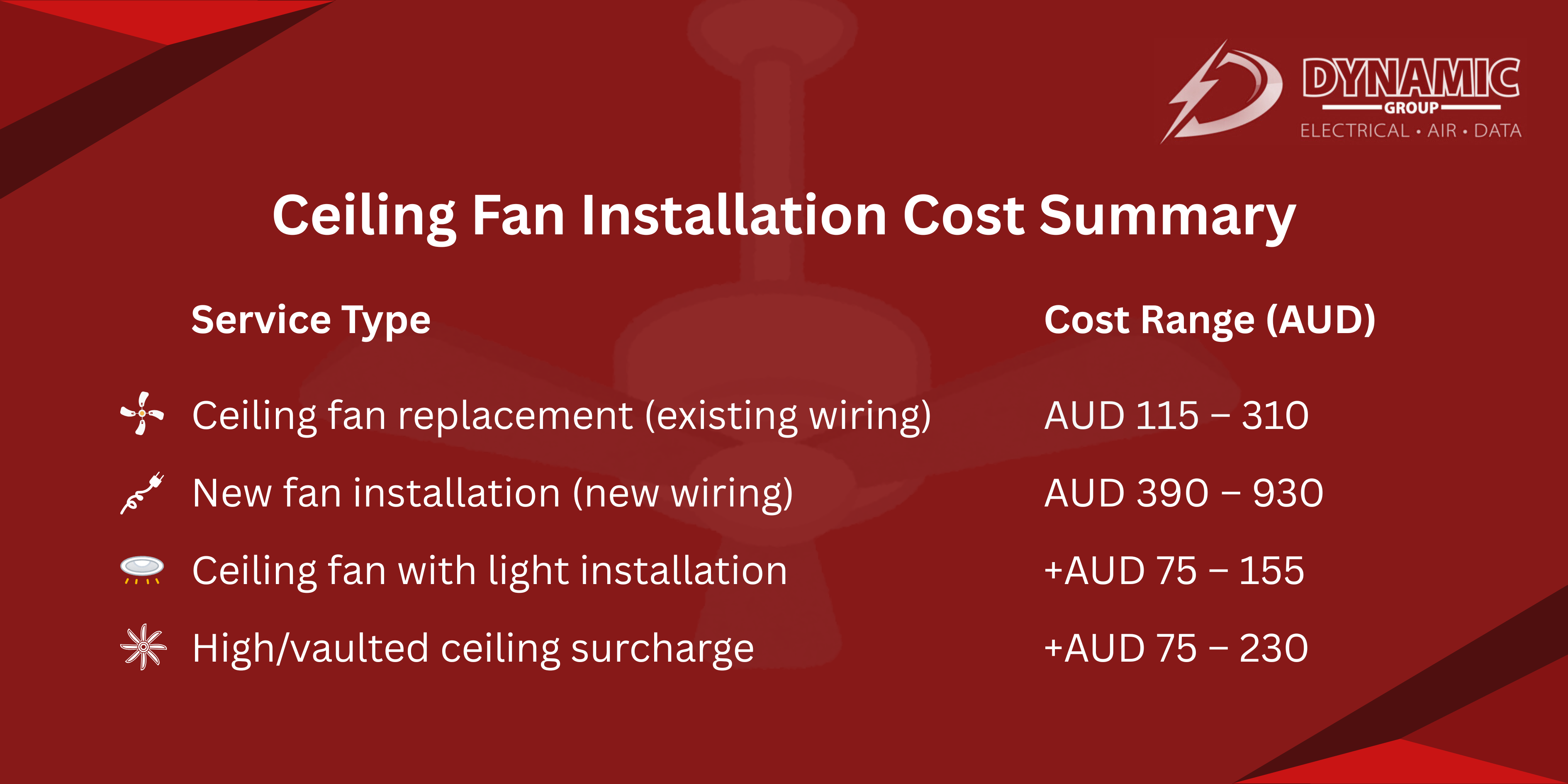
What's the Cost for Outdoor Ceiling Fans?
An electrician’s hourly rate encompasses the amount charged for one hour of electrical work, covering labour and sometimes the basic materials used in doing the job. However, it doesn’t always reflect the full electrician ceiling fan installation cost, as additional costs may apply for call-out fees, specialised equipment, or permit charges.
In terms of cost, an additional cost of AUD 450-1,000+ will be added in the professional fees because of the amount of technical work that needs to be done, such as:
IP-Rated Fittings
IP rating stands for Ingress Protection rating. It is an international rating (IEC 60529) used to define how well an electrical enclosure is protected against the intrusion of solid objects (dust, sand) and liquid (water).
Weatherproofing
Outdoor ceiling fans should be installed with weatherproofing to withstand the outdoor conditions.
Mounting Challenges
Outdoor ceilings might have different materials compared to the indoor ones. The material might be made of harder wood or special materials that will require adjustments to be able to carry the ceiling fan.
Additional Wiring
Installing an outdoor ceiling fan might require additional wiring. This could entail additional work time.
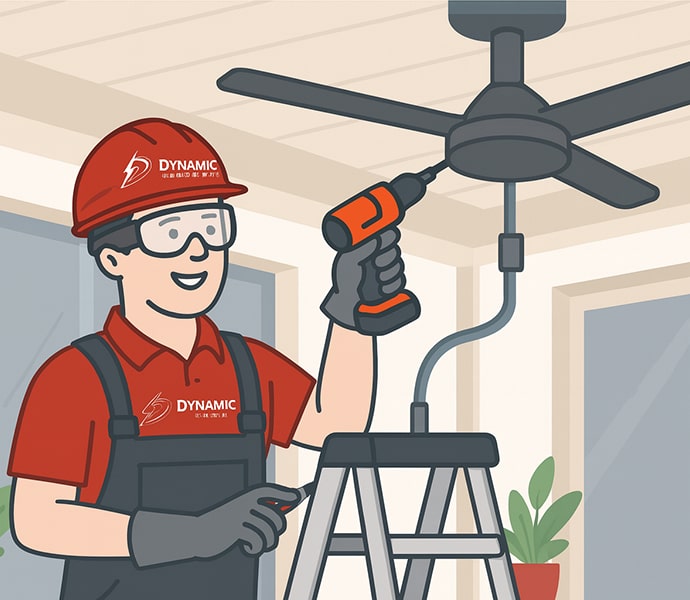
Factors That Affect Ceiling Fan Installation Costs
Several variables influence the overall fan installation cost of expert residential services in Perth.
1. Wiring Condition
If you're installing the ceiling fan in a new location, additional charges may apply for new wiring. However, existing connections can reduce ceiling fan installation cost, provided the wiring is still in good condition. This is why you need a licensed Perth residential electrician to know the present condition of your wiring. Hiring them can save you from problems like short circuits and how to fix it.
2. Ceiling Height
The standard ceiling height is 2.4 metres. For high or vaulted ceilings, expect an increase in the fan installation cost due to the need for special equipment such as scaffolding or extra manpower.
3. Fan Weight and Size
Fans larger than 50 inches or heavy-duty may require reinforced mounts, structural checks, and possibly a consultation with a structural engineer. These factors can increase the cost of installing ceiling fans
4. Fan Features
Smart ceiling fans with Wi-Fi, app control, or other tech features require specialised installation and expert residential electrical services. This may involve higher electrician ceiling fan installation cost and potentially IT-savvy technicians.
5. Location
Ceiling fan installation cost vary by region. The electrician's hourly rates in different cities vary. Perth, Sydney, Melbourne, Brisbane, Canberra, and Adelaide, tend to have higher rates. Meanwhile, rural areas may be cheaper but have limited electrician availability. Better check with our Perth home electrical specialists, such as the Dynamic Group.
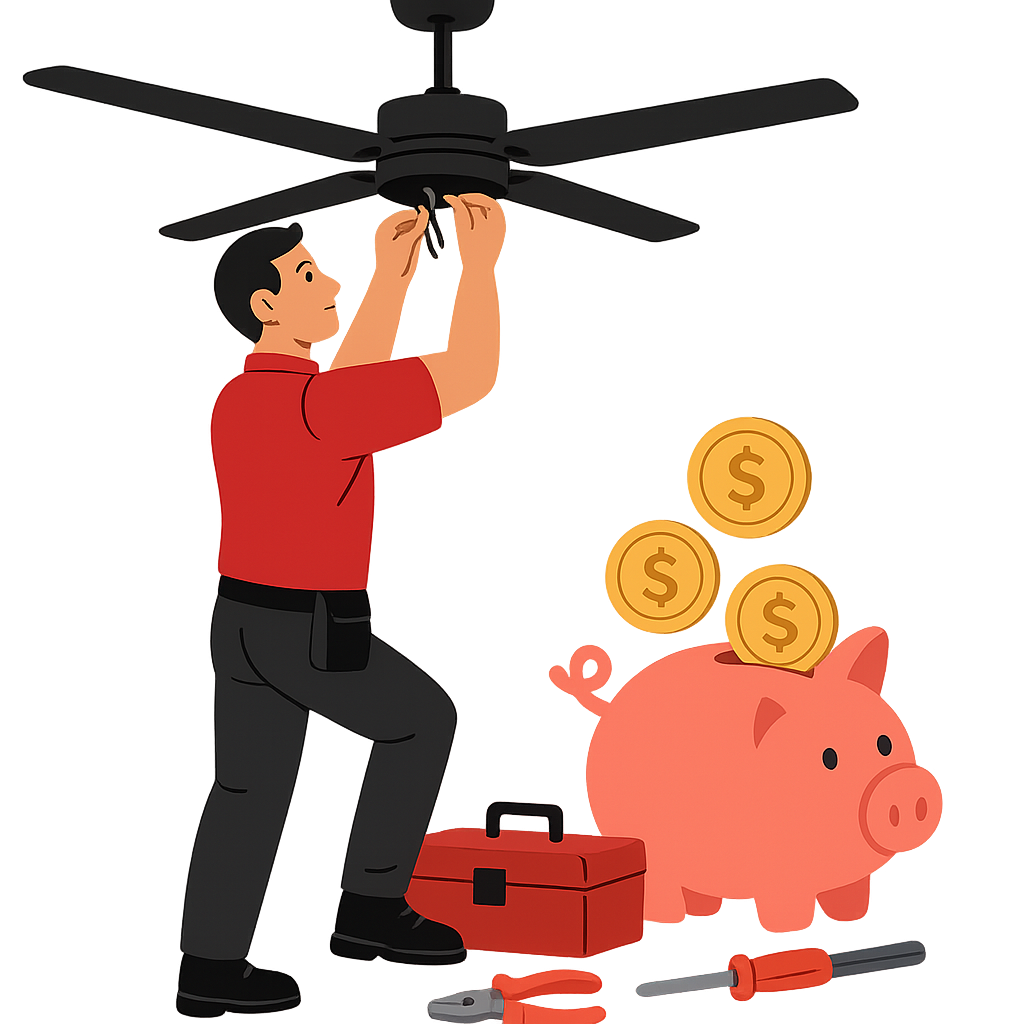
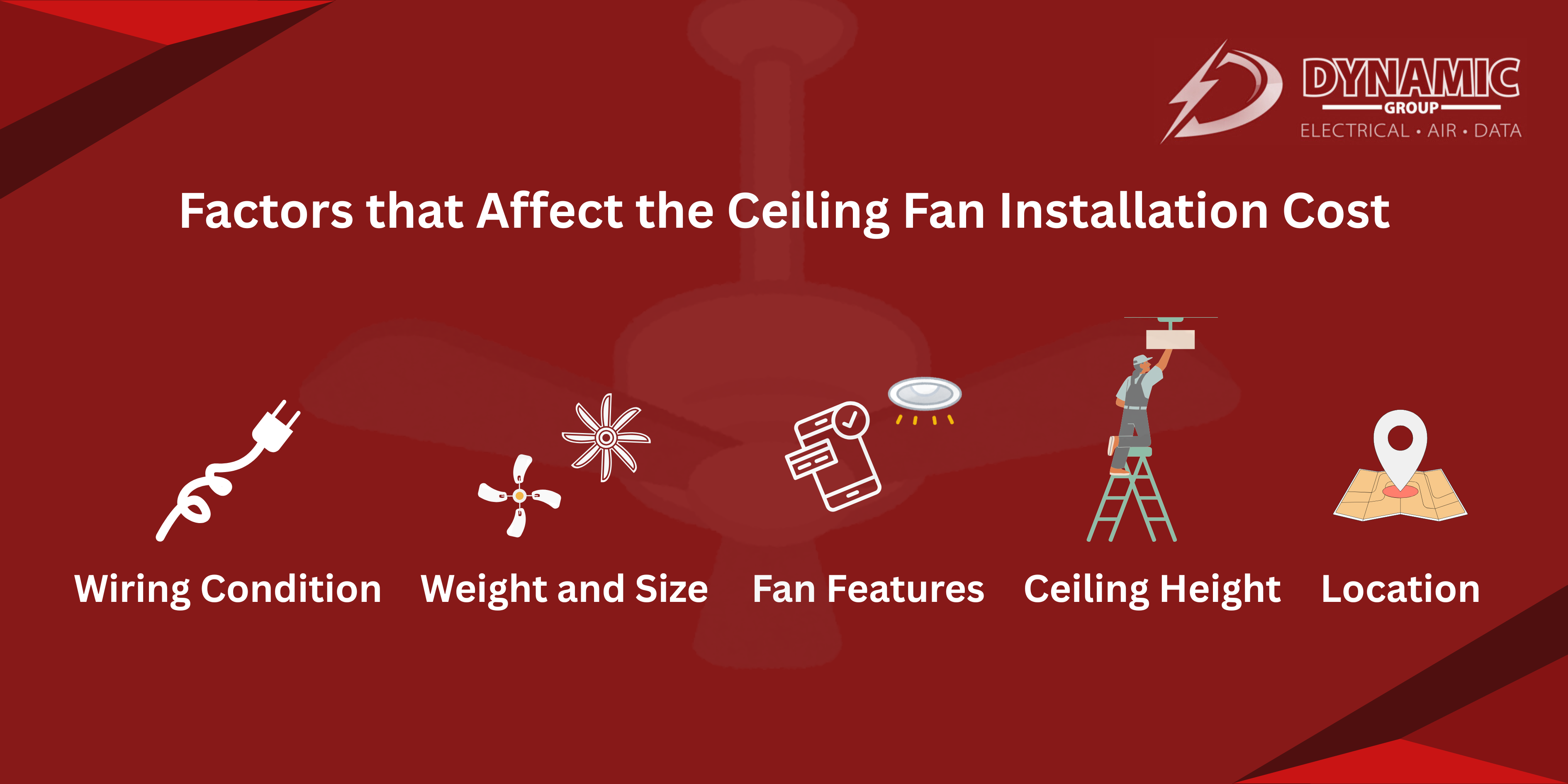
New Ceiling Fan Installation vs Replacement Costs
When upgrading your home’s cooling system, one of the key questions homeowners ask is whether it’s more affordable to install a new ceiling fan or simply replace an existing one.
Here's the breakdown:
Ceiling Fan Replacement
- Cost: AUD 155 – 390
- More affordable if the wiring and mounting hardware are intact.
New Ceiling Fan Installation
- Cost: Starts at AUD 390
- Higher cost to install ceiling fan due to additional wiring, structural work, or advanced features.
Ceiling Fan with Light
- Additional Cost: AUD 75 – 155
- It may require new circuits for safe power load distribution.
Only licensed professionals are legally allowed to install ceiling fans in Australia. DIY installations pose serious safety risks.
Smart Ceiling Fans (with app/remote control)
Additional Cost: AUD 100 – 250 for setup, programming, and testing

If you’re adding a ceiling fan to a room for the first time, the cost to install ceiling fan units is generally higher. This is because an electrician may need to:
- Run new wiring
- Install a junction box
- Ensure the ceiling can support the weight of the fan
In some cases, if the fan includes a light kit, the wiring work may be more involved, which increases the total fan installation cost.
Replacing an old fan with a new one is typically cheaper because the wiring and mounting are already in place. The cost of installing ceiling fans in this case is mostly labour for removal of the old unit and installation of the new one.
DIY vs Professional Installation
Electricians use different pricing models depending on the nature of the work. Some jobs are charged per hour, while others have a fixed rate.
For minor repairs, an hourly rate is standard. But, how much should an electrician charge per hour? Again, this would depend on the job and the provider. For larger projects, electricians may provide an upfront quote instead.
Pricing
Licensed electricians charge a reasonable amount for their customers. Their profession is regulated by the government, and can guarantee that their work is of quality. Though it raises the cost of installing ceiling fans, professional installation ensures safety and compliance. However, installing the ceiling fan on your own will totally save you from paying out professional fees, but will pose a high risk to you and your home.
Safety
Each work of licensed electricians follows the standard safety protocols of installing a ceiling fan. It ranges from the proper voltage, wiring, and other integrations, such as lights or smart technology. They can even do repairs if needed. Professional electricians can also foresee possible problems that might arise. It is best to listen to their recommendations as well.
Legality
Electricians in Australia need to be licensed in order to perform the role. They conduct safety checks and issue Certificates of Compliance.
They can also upgrade their license to be able to work in hazardous or high-voltage environments, Solar PV and battery storage systems (requires Clean Energy Council accreditation), Data and communications cabling (requires a separate Open Cabler Registration), and air conditioning and split-system installation.
Asking someone to install a ceiling fan without a valid electrician’s license poses serious safety risk, and is subject to penalties and possible void of insurance.
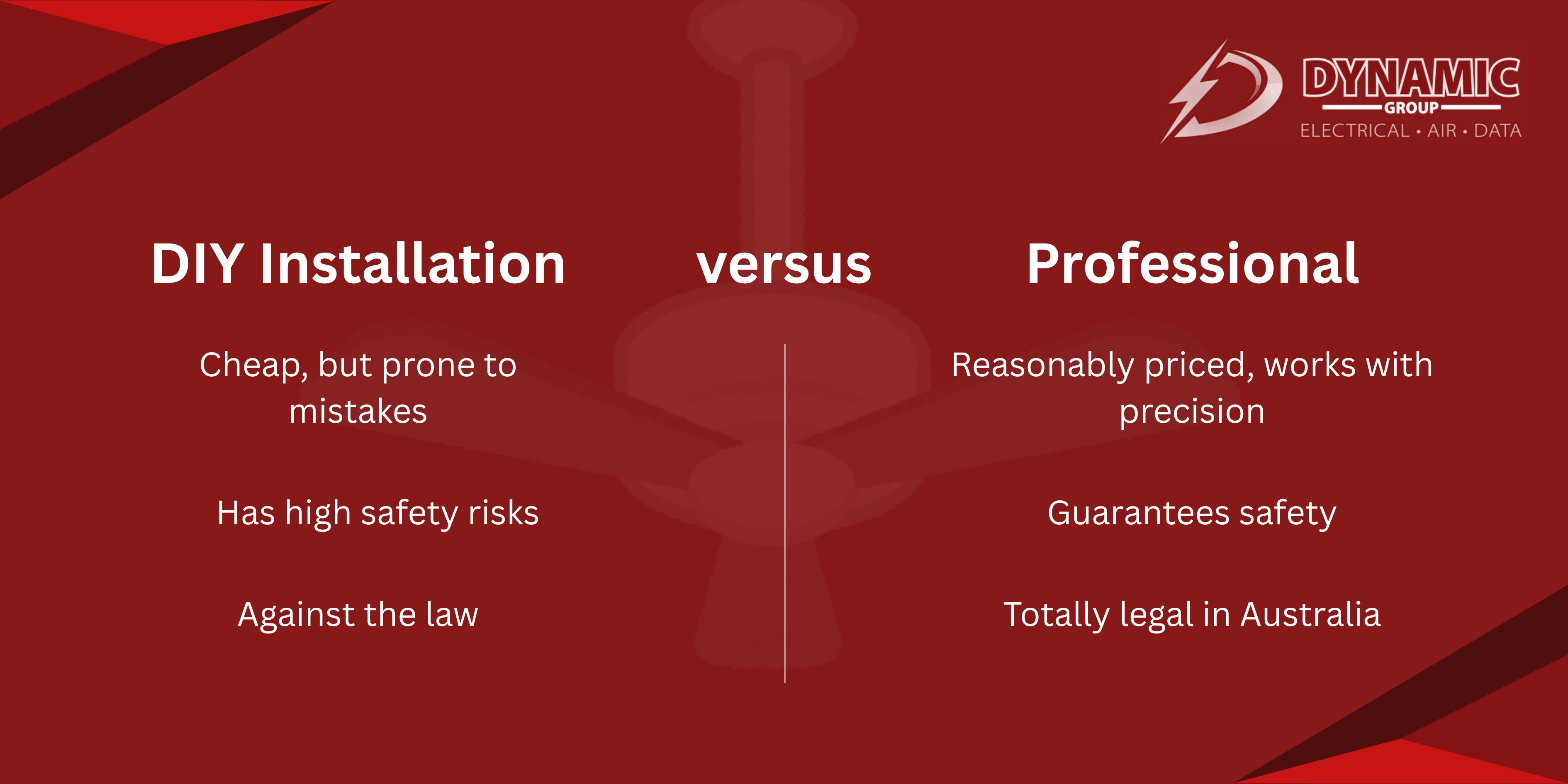
Ceiling Fan Prices in Australia
Fan prices vary based on brand, features, model, and design. Timing also affects cost—peak seasons typically see higher prices, while off-peak periods may offer better deals.
| Fan Type | Price Range (AUD) |
|---|---|
| Budget (standard models) | 75-155 |
| Mid-range (reversible, LED) | 230-465 |
| High-end (smart, DC motor) | 620-1,240 |
Tip: Always check warranty terms to ensure protection in case of early defects or damage.

The price of a ceiling fan depends on the brand, size, material, and features.
Fans with built-in LED lighting, remote controls, or smart home compatibility tend to sit at the higher end of the scale. Outdoor-rated fans, designed for patios or alfresco areas, also cost more due to their weather-resistant materials.
Factors That Influence Ceiling Fan Prices
- Size & Design: Larger fans generally cost more than smaller bedroom fans.
- Material: Timber-look or designer finishes are pricier than standard ABS plastic blades.
- Extra Features: Remote controls, reversible motors, and dimmable LED lights increase the cost.
- Energy Efficiency: DC motor fans are quieter and use less power, but they’re also more expensive upfront.
While buying the fan itself is the main expense, homeowners should also consider the cost of installing ceiling fans. Factor in the cost of ceiling fan installation. With the right choice, a ceiling fan is a cost-effective and stylish way to stay comfortable in the Australian climate.
AC vs DC Ceiling Fans: Which Is Better for You?
The difference between AC (Alternating Current) and DC (Direct Current) ceiling fans is the type of motor used and how it powers and controls the fan.
Here is a quick rundown of their unique features:
| Feature | AC Fan | DC Fan |
|---|---|---|
| Energy Use | Higher | Lower (up to 70% less) |
| Noise | Louder | Quieter |
| Cost | Lower upfront | Higher upfront |
| Remote / app | Sometimes | Standard |
| Reversible | Usually switch-operated | Remote / app |
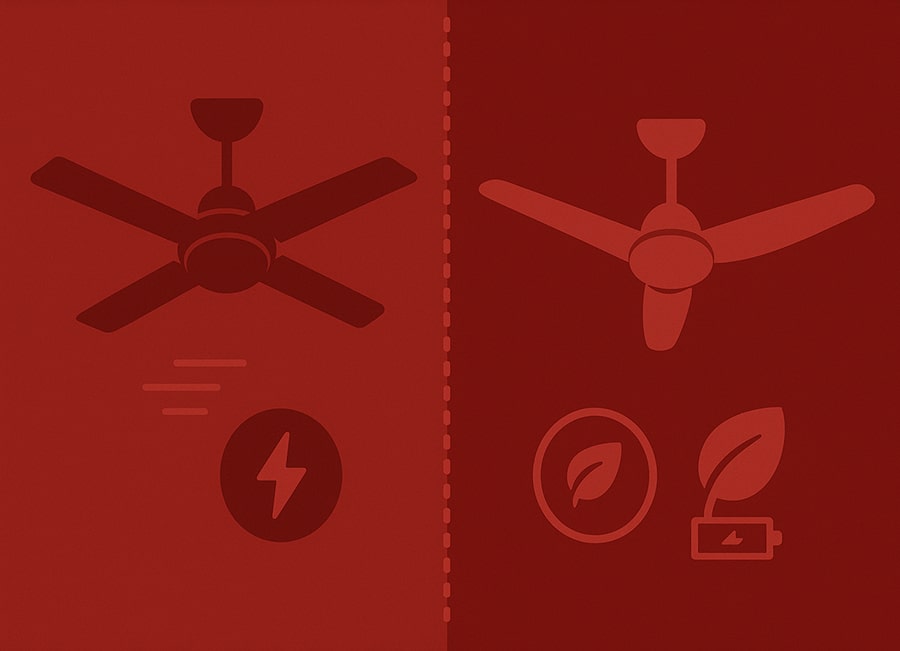
Either has its pros; yet, the selection usually depends on energy efficiency, style, and installation prices. Most homeowners in Perth also need to know the cost of installing a ceiling fan and whether the type of fan affects the price.
Energy Efficiency
If reducing power bills is your top priority, DC ceiling fans are the better choice. They consume 70% less energy than the AC fans do. The savings can offset the difference in purchase price over time.
Noise Levels
AC ceiling fans can be louder, especially when operating at higher speeds. On the other hand, DC fans are less noisy and are ideal for bedrooms, studies, and living rooms.
Cost of the Fan vs Installation Cost
- AC fans typically cost less upfront, making them a budget-friendly option.
- DC fans are initially more expensive, but they save on running costs.
In terms of installation, however, the difference is negligible. The installation cost of a ceiling fan is usually similar for both.
This implies that the cost variation is primarily due to the fan, not the electrician's ceiling fan installation cost.
Controls & Convenience
- AC fans often rely on wall switches, with remotes as optional add-ons.
- DC fans often include a remote or app-based control, providing greater flexibility and ease of use.
Reversible Functions
Both fan types feature reversible directionality, allowing them to be used in both summer and winter. AC models often feature a small switch on top of the fan body, but DC models can have you reverse direction using the remote or app instead — much more convenient.
Either way, keep in mind that the cost of ceiling fan installation is a crucial factor in your decision. From the price of installing ceiling fan units in new homes to calculating the cost of installing ceiling fans Australia-wide, the most logical thing to do is to obtain a clear and concise quote in advance from a licensed electrician.
Whichever fan you choose, always match it with an experienced electrician so that your ceiling fan installation cost turns out to be money well spent, and your home remains cosy throughout the year.
How Much Does It Cost to Run a Ceiling Fan?
Ceiling fans are one of the most cost-efficient cooling appliances. Many models also serve as lighting fixtures.
Running Cost (Approximate):
Hourly: AUD 0.015 - 0.08
Monthly (8 hrs/day): AUD 3 - 8
Ceiling fans are 50–90% cheaper to run than air conditioners. Learn how AC and DC fan motors differ to find out which offers better energy efficiency and quieter performance
Modern energy-saving features include:
- LED lights
- Timers
- Eco-modes
- Reversible motors (for summer/winter use)
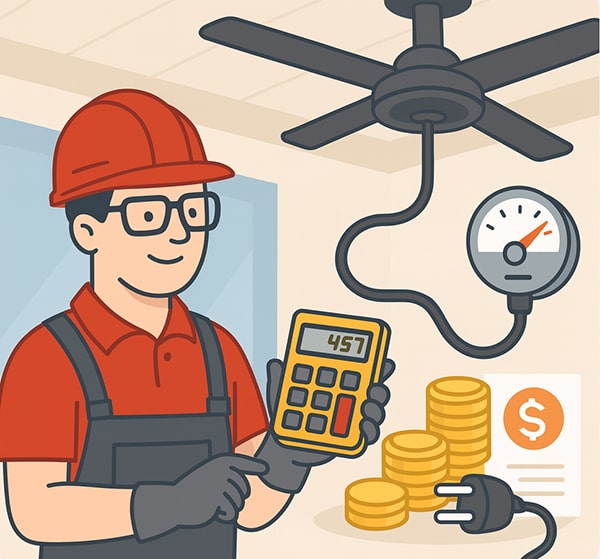
Ceiling fans are one of the most affordable ways to cool your home. Unlike air conditioning, which can add hundreds to your energy bill, running a ceiling fan uses very little electricity.
The Running Cost of a Ceiling Fan
A typical ceiling fan uses between 15 and 90 watts depending on the speed and size. On average, this translates to less than 1 cent per hour of use. For example:
- Running a ceiling fan for 8 hours per day usually costs only $3–$8 per month.
- Even heavy daily use is unlikely to exceed $30 per year, making ceiling fans one of the most energy-efficient cooling options available.
Compared to an air conditioner, which can cost several dollars per day to run, a ceiling fan is an incredibly budget-friendly solution for keeping comfortable.
Factors That Affect Energy Costs
- Fan Size & Speed – Larger fans or those running on high speed draw more watts, but the increase is still minimal.
- Motor Efficiency – Energy Star–rated fans often use even less electricity.
- Usage Habits – Running fans only when you’re in the room saves even more.
The truth is the real expenses are tied to the price to install ceiling fan systems. But after installation, the ongoing cost of running a ceiling fan is one of the lowest household expenses you’ll have.
Ceiling Fan Installation Cost FAQs
Thinking about installing or replacing a ceiling fan? This short FAQ covers the basics—what’s involved, typical considerations, timeframes, ceiling fan installation cost, and who should do the work—so you know what to expect before you book. If your question isn’t answered here, reach out and we’ll help.
We hope this FAQ gave you a solid head start. If there’s anything we didn’t cover, get in touch and we’ll gladly answer it.
In a Nutshell
Planning ahead when installing a ceiling fan saves time and money. It can be whether simply replacing an old unit or you are installing a new one, the key is to have proper scheduling and the ceiling fan installation cost in your budget.
Either way, always seek qualified residential electricians because your safety depends on it. Additional expertise may be needed for smart fans to ensure integration with your home automation system.
Also, buying during the off-season or during cold months increases your chances of getting better deals and promotional offers.
For optimum quality electrical service and peace of mind, only trust professionals like Dynamic Group to handle your installation properly and efficiently, ensuring the fan installation cost delivers real value.














